Bright Data (formerly Luminati Networks) is a web data giant which offers a comprehensive range of proxies in countries and cities all around the world.
Need residential proxies? The company has 72 million shared and exclusive IPs across 195 countries. They're sourced from user devices, but if you're looking for more reliability and speed, Bright Data also has 600,000 proxies sourced direct from ISPs.
Mobile proxies give you IPs from real mobile devices. Most proxy providers don't offer them: Bright Data has more than 7 million.
If your needs are simple, the company's datacenter proxies offer great performance at a much lower cost. But even here, Bright Data outperforms most of the competition, with a 700,000+ proxy pool spread across 3,000+ subnets, and both country and city-level targeting.
- Want to try Bright Data? Check out the website here
Using Bright Data in a basic form can be as easy as setting up its Chrome extension. There's no coding involved and it's only marginally more complicated than using a commercial VPN.
Bright Data's open source Proxy Manager also bypasses the need for coding, but adds many powerful and advanced features: SSL decryption, intelligent routing, custom rules to reduce bandwidth use, and more.
Additional products add web scraping and related abilities. Web Unlocker can solve CAPTCHAs and automatically retry for better success rates; Data Collector fetches hundreds of standard data types (Google search results, Amazon products, social media profiles, YouTube contents) using your search terms; Search Engine Crawler gets you precisely geo-targeted search results for any keyword, on every search engine.
Whatever you're using, support for unlimited concurrent sessions helps to maximize performance. A quoted 99.99% residential proxies uptime guarantee suggests Bright Data is confident about its tech, but if you do run into problems, support is available 24/7 to get your project running smoothly again.
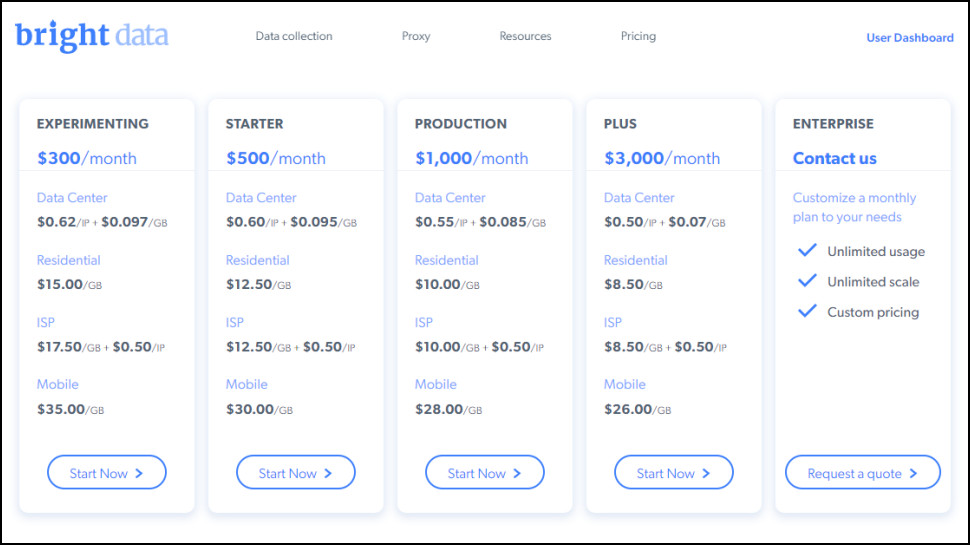
Pricing
Bright Data has multiple pricing options for each of its four IP address types: data center, residential, static residential and mobile.
Simple pay-as-you-go plans are available for $0.90 per IP and $0.12 per GB for datacenter IPs, or $0.50 per IP and $29 per GB for static residential IPs. Residential IPs are priced at $25 per GB, Mobile IPs are $60.
Committing to a monthly payment gets you traffic and IP at a better price. For example, $1,000 a month for the Residential Production plan cuts residential proxy costs to $10 per GB, while mobile traffic drops to $28 per GB.
Signing up for a year saves you another 10%. Opting for the $270 a month Experimenting plan gets you datacenter proxies for $0.558 per IP and $0.0873, for instance, with residential proxy traffic at $13.50 per GB. At the other end of the scale, the $2,700 a month Plus plan asks $0.45 per IP and $0.063 per GB for datacenter proxies, and $7.65 per GB for residential.
There are trials in some situations, although the rules are quite complicated. You can get a 7-day trial for residential proxies, for instance, but only the rotating type (not static), and you're signing up for a company, and you can verify company registration and ownership, and you're spending at least $500 a month. Freelancers must make do with a 3-day money-back guarantee.
These prices are above average, and you can get lower starting prices with most providers. Smartproxy's Micro plan enables dipping your toe in the residential proxy waters from only $75 a month, and its $15 per GB cost is only fractionally higher than Bright Data. And you can bring this down to $8 per GB for a very reasonable $400 a month, while Bright Data asks $2,700 a month to reach a similar price point.
Bright Data does deserve credit for its pricing flexibility, though, and the Pay-As-You-Go option makes it easy to see if the proxies have the quality to justify their price.
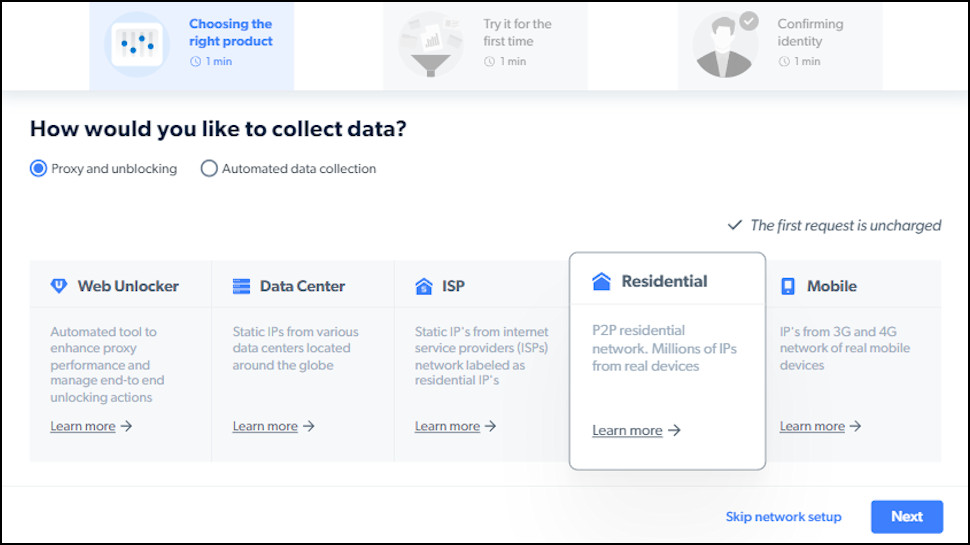
Signing up
Getting access to Bright Data starts with handing over your details to create an account. It's all set up in a few seconds, and the website redirects you to Bright Data's web dashboard.
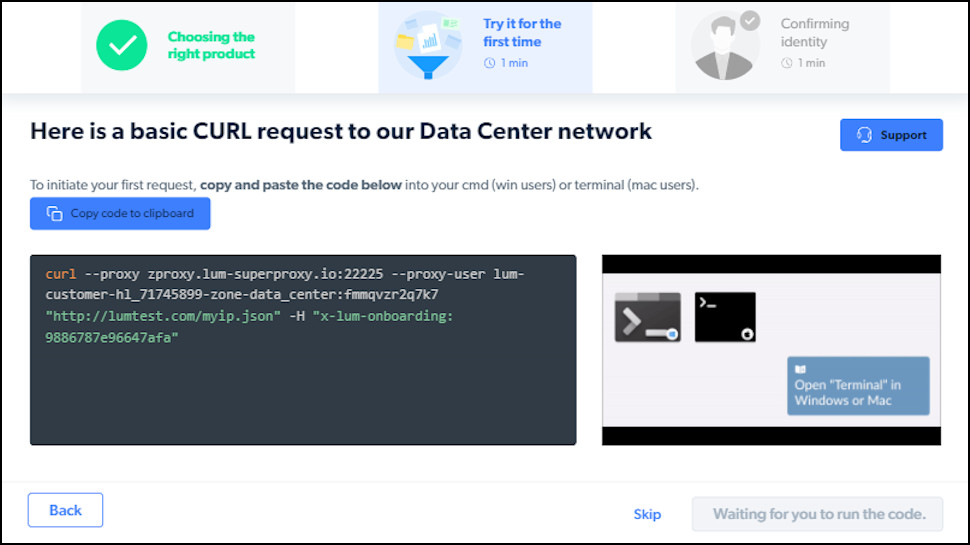
This prompted us for the type of product we needed - datacenter proxies, mobile, residential and so on - before displaying a basic cURL request to see how the service works.
The site next asked us to verify our identity. It's a hassle, but Bright Data has found a way to make it more acceptable. Hand over your credit card, PayPal, Alipay or Payoneer details, the company charges you $1, but credits you with $5. There's no commitment and you're not automatically charged again, but having a positive account balance does mean you're able to access Bright Data's dashboard and run maybe 5-6GB of datacenter proxy texts.
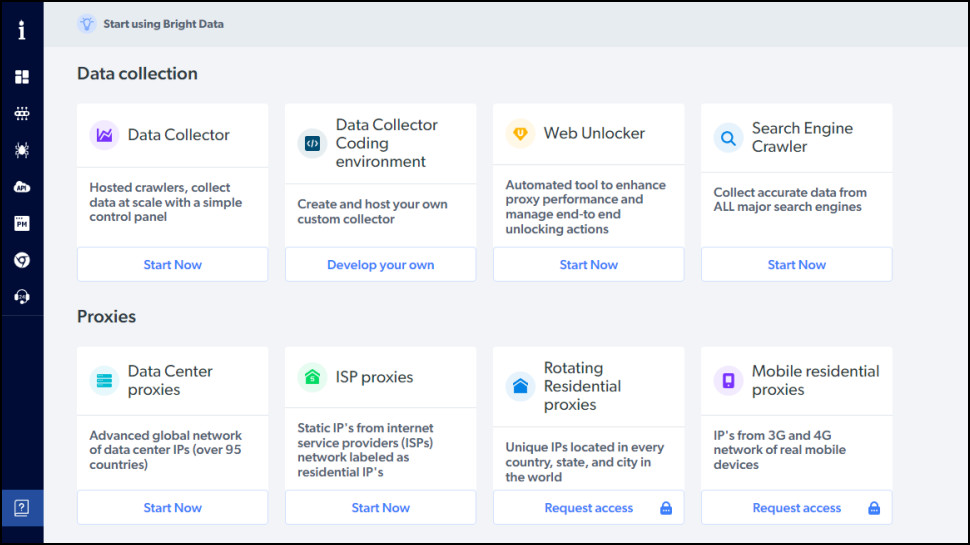
Dashboard
If you're new to the proxy world, or just used to much smaller providers, Bright Data's web dashboard could be an intimidating surprise. No simple text boxes with lists of proxies here: instead, there's a bunch of summary information, charts where you can monitor your proxy use later, and a sidebar with icons for various areas of the service: zones, the Chrome extension, proxy manager, API setup, reports, account settings, billing and more – and many of these have their own complexities to explore.
Check out the guides in the 'Start using Bright Data' section of the support site, though, and you'll begin to see it's not quite as involved as it first looks.
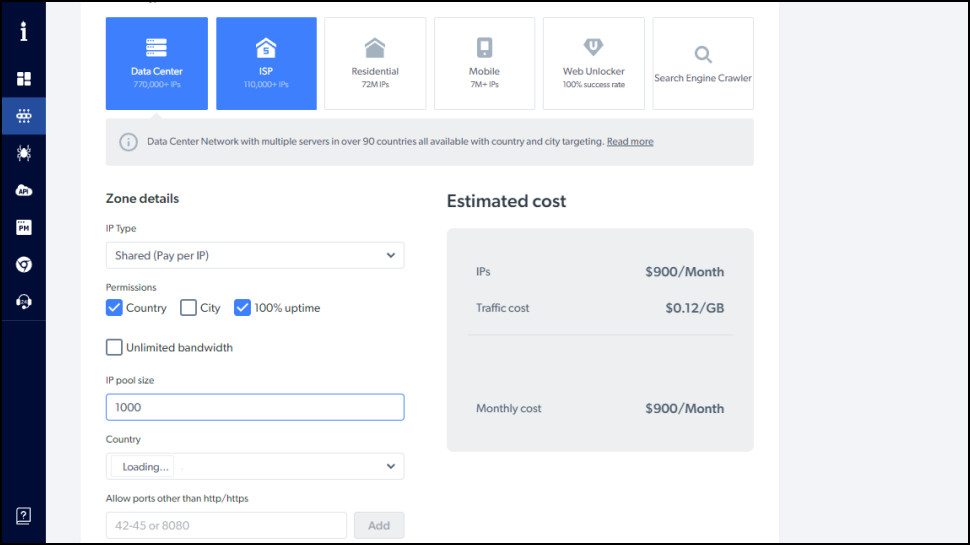
The site first asks you to create a Zone, for instance? A what? Turns out this is really just a group of settings which defines your project: the type of IP addresses you'd like to use (data center, residential, static residential, mobile), your preferred IP type (shared, exclusive), the IP country, state, city, carrier and more.
Once you've created a zone, you can customize it in many ways, for example limiting zones to particular domains, or adding specific domains which you don't want to target.
The value here is you can create multiple zones, each with their own settings and permissions, and reuse them with particular project types. (Bright Data allows you up to 50 zones for free, and you can pay to add more if necessary.)
But if you don't need any of these interface or management extras, you can access all the usual data you need in a click or two. A zone Details page lists your proxy user name and password, for instance; gives you the ability to add trusted IPs to an allow-list; and can display your allocated IPs, or download a file containing your IPs in the form IP:PORT:USERNAME:PASSWORD.)
There's still significantly more to learn with Bright Data than almost all of the competition. But it's not difficult, and these extra layers are handy for heavy-duty users or anyone with multiple projects to manage.
Going further
Bright Data's web dashboard may be stuffed with proxy-handling technology, but it's not all the company has to offer. There are other tools to help you access, use and manage your proxy projects.
Bright Data Proxy Browser Extension is a Chrome add-on which enables using your proxies direct from the browser. At its simplest, you can use it much like a VPN: choose a country, connect, then visit your target sites, run searches and do whatever else you need.
As this is Bright Data, though, of course the proxy is also amazingly configurable. You can change the user agent, of course. Customize DNS. You can even allow others to use the extension without giving them your Bright Data login, very handy when you need help in managing a project.
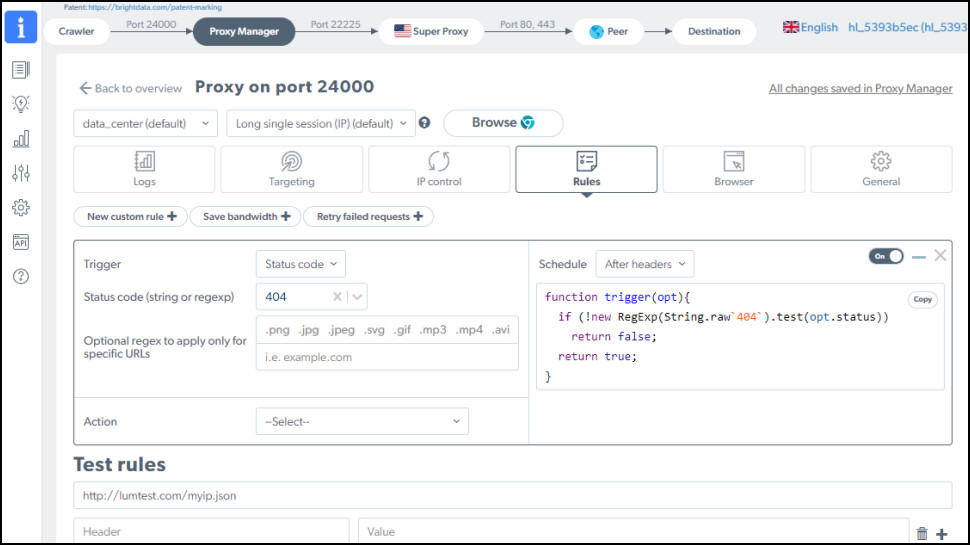
Bright Data's Proxy Manager is an open-source desktop tool which is crammed with ways to automate and optimize your proxy projects.
You can create custom rules to define which requests are routed through the proxy and which can use your regular connection, for instance, cutting costs. And smart handling of connection problems includes the ability to automatically retry on failures, or blacklist IPs which give you bad results.
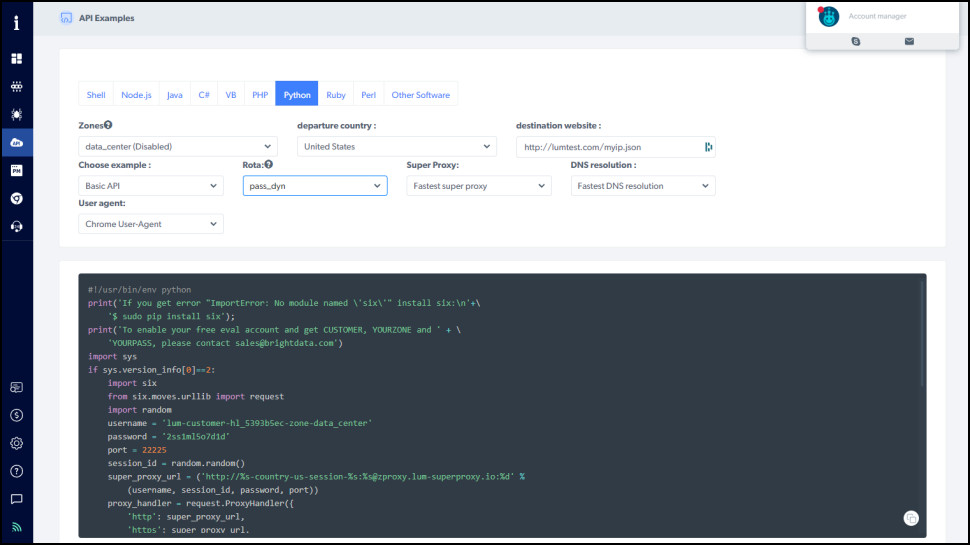
Bright Data also provides a custom API. You'll need some development experience to use that, but the Bright Data web dashboard does a lot to speed up the process by making it easy to automatically generate the necessary code.
At a minimum this could involve choosing your zone, exit node country and destination side. Other options cover routing, DNS preferences and your choice of user agent (Chrome, Firefox, IE or none).
By default, this generates example shell code, but Node.js, Java, C#, VB, PHP, Python, Ruby and Perl scripts are just a click away. If that's not enough, there are also custom instructions on how to set up a browser or other custom software with the details it needs. (We're not talking some generic text about 'go here to set up proxy', either – this has the proxy name, port and user credentials you need to configure the software for your chosen settings.)
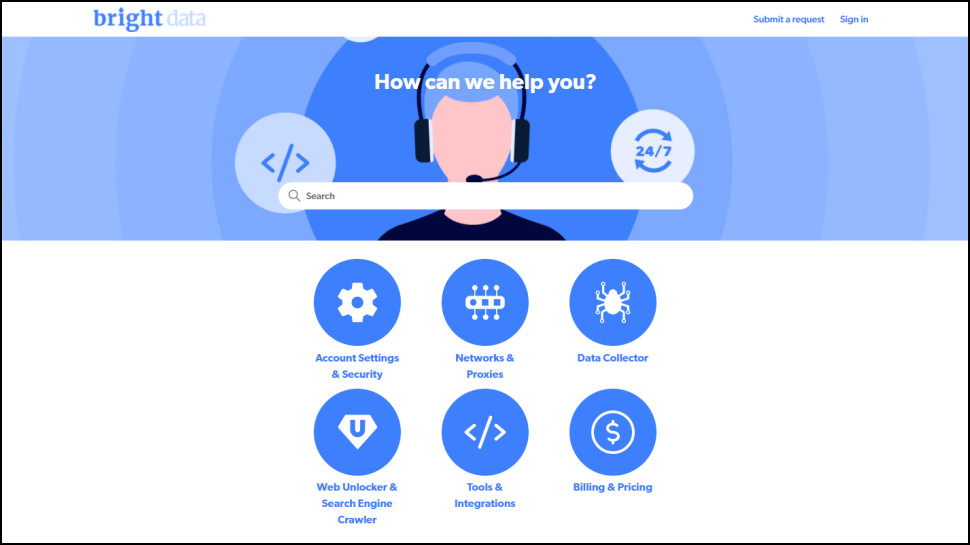
It's a comprehensive setup which should get you started very quickly. You'll probably have plenty more work to do to get everything working as you expect, but the Bright Data support pages have further details and code samples.
Final verdict
Bright Data is more expensive than most providers, and can be far trickier to set up. But its huge network, flexible billing and highly powerful and configurable tools make it a must-try for serious users and demanding projects.
We've also highlighted the best proxy and best VPN
from TechRadar - All the latest technology news https://ift.tt/Ecs8Uv7

No comments:
Post a Comment